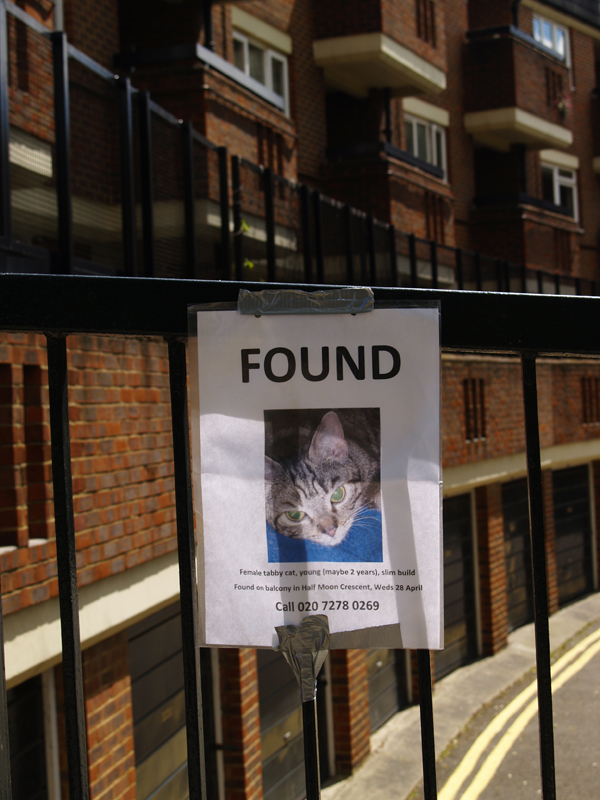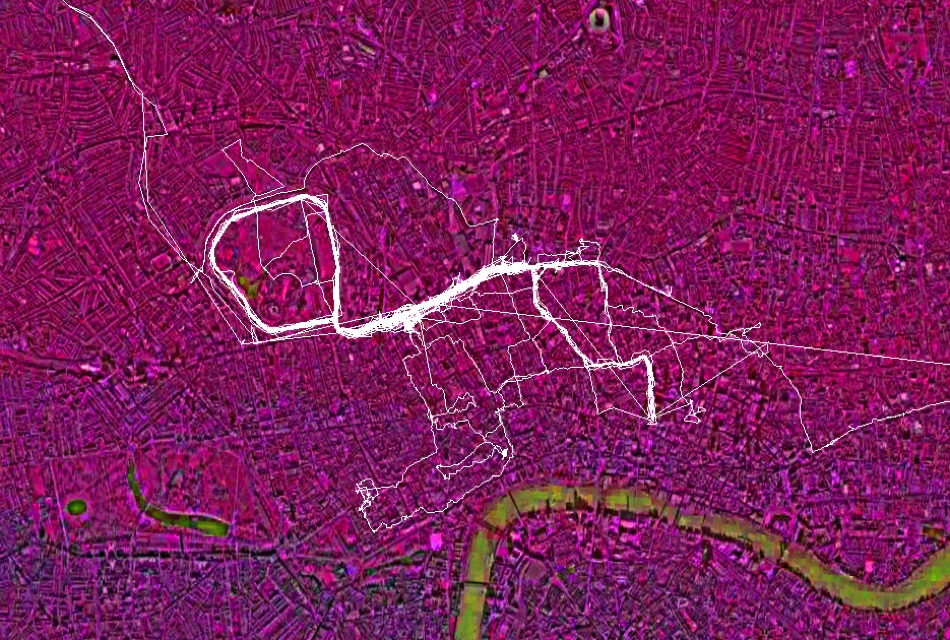TRANS-DIMENSIONAL RUNNING FOR OUR LIVES! A ROUGH GUIDE: IN THE CHAOSMOS OF OUTSIDE/IN. Or: Why running is an excellent tactic for the urban dweller.
** Breaking news: Currently #5 in the War of Films contest: CLAUDIA TOMAZ’S film about KAIDIE AND HER MEANING OF LIFE 3.0. VOTE NOW!** Vote by clicking on + sign at the top of video player. ** Don’t forget to vote for Episode 2, Run Kaidie Run, too!**

As we ran about in our neighbourhood on voting day May 2010, we found something found, and not lost. For a change. But perhaps she was unwanted, as it had been more than 2 weeks. Or perhaps she was the one who decided to leave, to have a new place to dwell.
In the physical, primary world of Life 1.0[1], running as a means of navigating the urban landscape has the clear advantage of not increasing our carbon footprints. While this single reason should be compelling enough to persuade the uninitiated, there are several more reasons – philosophical, poetic, psychogeographical, personal and political – why running is an excellent tactic for the urban dweller.
When we run in the city, we are able to personalise what could otherwise be an anonymous, alienating and brutal landscape. While located as an extension of the long traditions of walking (Benjamin, Debord, Richard Long, Lake District writers, Herzog et al), reality becomes more heightened for the runner (with the increased heart rate, speed, physical duress et al given the high impact activity). As an everyday (and legitimate and safe) activity, running departs from other urban tactics such as parkour, skateboarding and grafitti.
We can outrun our fears and danger when we run in the city. We could allow ourselves to be intimidated by the oppressive Barbican buildings and its heavily concrete surroundings, or, we could find our own ways around it, by running it. Running through a council estate in Peckham enables us to conquer our insecurities and paranoia, real, imagined or simply rumoured. If we have no physical advantage over another person (especially if one armed with a weapon, a hoody and ugly tracksuits, a fighter dog or ill-intent), like the Kalahari endurance hunter, we understand that we have our tenacity to rely on, that will allow us to outrun any potential matters of life and death.
Let all the 10,000[2] CCTVs in London follow our movements, for we will register as nothing more than blurs, as if in a Marinetti painting. Haussmann built broad boulevards that were not only beautiful for the flaneur (including those on hashish) to stroll on, but easier for Napoleon’s troops to run down delinquent Parisiens. We could theoretically outwit that, by running through it, as Lola did Berlin, not once but thrice, in Lola Rennt (Tom Twyer, 1998). (Indeed, Lola not only made us see different faces of Berlin, she overcame her useless lover’s problems and overturned her own fate). In precisely-built concrete jungles, the runner can find small ways to defy grand narratives, by running and discovering unknown alleyways and pockets of areas that are neglected. For tightly controlled cities that have been infamously described as having chaos is that is ‘authored’ or absurdity that is ‘willed’, running is a gesture that we can adopt as a comeback (also to the one who described it as such). If we have nowhere to run to, or to run away from, we can discover new spaces within a difficult system, to run. This is one way to ‘not let the bastards grind us down’, as the angry young Arthur reminds us in Sillitoe’s other Kitchen Sink classic, Saturday Night Sunday Morning.
Running also offers a refreshing filter for us to explore a foreign city. When we run in a new city, we interpret landmarks in ways that differ from the overexposed versions pushed forward by tourist books and postcards. Being literally and metaphorically on the ground, we can also run into places – including those that are filled with chaos and absurdity – that would otherwise be whitewashed from the glossy official or so-called authoritative versions. Exposure to the unedited and un-Photoshopped places can open our eyes, ears and minds to other, perhaps more meaningful micro-narratives than the overarching ones.
As runners, we also cease to be taken as ignorant foreigners or exotic Others who are vulnerable, helpless or simply irritating (although we now irritate in other ways, by for instance, ‘endangering the lives of other [slow] users of the pavement’, and so on). While we have previously seen how remains vital to assume the ideological position of an outsider, it is also strategic to look like a local every now and then. Other tourists or even locals ask us for directions, as if the runner has a greater authority on the given site. Indeed, we do.
Virtually anyone can run anytime, anywhere. While it remains unfathomable how the ‘female species’ are still viewed as ‘the weaker sex’ in the 21st century (this is a separate discussion that warrants another 2010,000 theses, and more, but not this one), running is a method in which the female urban dweller could subvert this tiresome outlook. While the female runner is still likely to be spectated upon, she is soon gone, away from any actual bullying that might have befallen someone in a slower mode of navigation. In return, we can enjoy a few moments of tokenistic reciprocations of taunts (after all, we have been at the receiving end from the beginning of time, since having allegedly been created from some spare rib, according to one best-selling storybook), by deliberately making eye contact with the male spectators, but swiftly sprinting off, as if saying ‘catch me if you can’. They do not, and / because they cannot, and they know it only too well. Hence, the look of impotence. A female runner navigating the big city alone can be a sign of physical and mental strength and confidence, thereby warding off any unwanted attention. Or, perhaps it is the face of intense concentration, or simply the excessive (and offensive) perspiration (and animalistic panting) of the serious female runner that desexualises her for the male spectator.

One female, foreign urban-dwelling runner is always warming up. Left: June 2010. Middle: April 2010. Right: May 2010, with our Garmin Forerunner 405 with a broken strap (due to our excessive perspiration, perhaps), here seen taped down to our wrist. We try to use brown tape instead of say, black gaffer tape, for aesthetic purposes as the former can blend in with the colour of our skin. You could not have seen the tape had we not pointed it out, could you?
Running in the city, we produce our own desire paths that subvert tracks laid out for us by the city planners. Should we have a Global Positioning System (GPS) device, we are also able to literally draw our own desire paths. In this way, we create our own unique marks in the midst of the concrete jungle. Akin to the graffiti artist’s surreptitious insignias on walls or trains (or the dog’s trail of urination in the streets), GPS drawing allow us to register our place and existence in the urban landscape. These new tracks, and indeed maps, can be shared with the online community on GPS-sharing sites[4], and further modified collaboratively[5]. From these, further mashups can be created. Like the Situationist tactic of deliberately reading a map upside down, the trans-dimensional runner can appropriate the mashups in innovative ways. In this manner, a lively Life 1.0-Life 2.0-Life 3.0 translation process is generated, all in turn allowing us to return to explore, question and understand our relationship with the city, and indeed, the builders of the city.
The glories of GPS aside, running in a city that we are unfamiliar with without a map can be liberating. Even in a city that we think we know, running without a map can open our eyes, ears and minds in new ways. In an age in which every frontier has been marked, mapped and fully known, such are small ways in which we can re-imagine and re-assess the environment that we live in, as well as its dwellers, including ourselves.
Running in the city, we can run away without physically away. Our minds travel while we remain fully embedded in the urban din. That it is neither illegal (as graffiti is), esoteric (as tai-chi is), extreme (as base jumping is, in which people jump off skyscrapers), technically-complex (as parkour is) or requiring special equipment (as nordic walking does), is the forte of running. Running is so simple as to be banal. While the likes of Roger Deakin, Byron and Martin Amis have made the activity of wild swimming sound lyrical, that it necessarily takes place outside the city, in somewhere unchartered and, indeed, wild, makes it escapist. With running, we can remain fully within a / the system. The ability to conform to a system while playfully questioning it, is an important point of the tactic of trans-dimensional running. Rather than to deny the city or reject reality, running allows us to opt in and play by the rules of the games, while slyly overturning them in personal but powerful ways. Running allows us to take ownership of a place that can be otherwise intimidating and prohibitive. By running, we see the city unpack itself in new ways that in turn also open us up.
This is an edited extract from a chapter. Where on googleearth does Kaidie do her writing (and some thinking)? Where is the place in Nondon that inspires us to generate such mindblowing, worldchanging, teethbearing words of wisdom?? To find out, read the next post!
[1] The various lives have been defined in the following ways in this thesis (as of 10 August 2010): Life 1.0 refers to the primary, physical world, ‘reality as it is’. Life 2.0 refers to the realm of imagination, ‘reality as I like’, as well as realities made possible by Web 2.0. Life 3.0 points to our current hybrid, mixed and augmented realities made possible by Web 3.0. Life 4.0 refers to ‘Web 4.0? and other future technologically-enabled realities, as well as other cycles of our lives to come, in the form of transmigration.
[2] Justin Davenport, ‘Tens of thousands of CCTV cameras, yet 80% of crime unsolved | News’, London Evening Standard, 19 September 2007 [accessed 9 August 2010].




